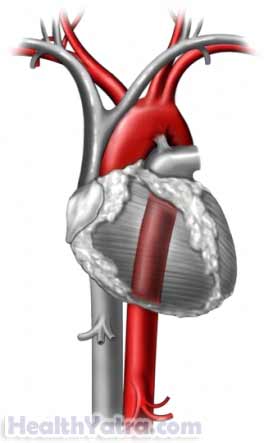Definition
Aortic dissection occurs when the layers of the aorta separate. The aorta is the main artery leading from the heart. Arterial walls have three layers. A tear in an inner layer can admit blood under pressure that works its way between layers, causing the layers to dissect apart or separate. This process can squeeze off the main channel so that blood cannot get through the main aorta or any of its branches.
This is a life-threatening event since it can cause stroke, sudden heart failure, or death to impaired blood flow to a number of vital organs. The enlarging mass of misdirected blood can also compromise nearby structures such as the airways, lungs, or heart. Or it may rupture with catastrophic bleeding.

Causes
Elevated blood pressure and a diseased aorta are the principal causes, usually due toatherosclerosis. Other congenital and acquired afflictions of the aorta also increase the chances of dissection.
- Hypertension
- Chest injury or surgical mishap
- Hereditary connective tissue disorders (eg, Ehlers-Danlos syndrome, Marfan’s syndrome)
- Late pregnancy
- Tertiary syphilis
- Smoking
- Hyperlipidemia
Risk Factors
The following factors increase your chance of developing aortic dissection. Be sure to discuss any of these risk factors with your doctor:
- Hypertension
- Atherosclerosis
- A major chest injury, such as an auto accident
- A hereditary connective tissue disorder
- Nearing the end of a pregnancy
- Untreated syphilis
Symptoms
If you experience any of the symptoms below, see your physician. They may reflect aortic dissection or many other serious and not-so-serious conditions. These are the most common, but there are many other possible symptoms since the aorta supplies blood to every organ in the body except the lungs.
- Sudden, ripping pain in the chest and or back
- Stroke
- Fainting
- Shortness of breath
- Sudden weakness
Diagnosis
The usual case of aortic dissection appears in the emergency department as a sudden catastrophic event. Your emergency physician will ask about your symptoms and medical history, perform a physical exam, and then rapidly proceed with any of several possible imaging studies.
Tests may include the following:
- Chest x-ray —a test that uses radiation to take a picture of structures inside the body
- Echocardiogram —a test that uses high-frequency sound waves (ultrasound) to examine the size, shape, and motion of the heart
- CT scan —a type of x-ray that uses a computer to make pictures of structures inside the body
- MRI scan —a test that uses magnetic waves to make pictures of structures inside the body
- Aortography—x-rays taken after dye is injected into the aorta through a surgically placed catheter
Treatment
You will most likely be admitted to the intensive care unit (ICU) for stabilization and further evaluation. Blood pressure will be controlled, and you will be carefully observed.
One type of aortic dissection requires immediate major surgery. Another type can often be managed without surgery (if no blood vessels are obstructed). It depends on where in the aorta the dissection occurs. Sixty percent of patients treated for aortic dissection are alive 10 years later. Treatment options include the following:
Surgery
The chest is opened, and the aorta is repaired. A length of Dacron (called a stent) may be used to replace the damaged segment of aorta. This is as major as surgery gets.
Medical Treatment
Your blood pressure will be reduced to minimize stress on the aorta. You may undergo repeat imaging studies every 6-12 months to detect further dissection.
Prevention
To help reduce your chance of aortic dissection, take the following steps:
- Follow and control blood pressure
- Ask your doctor to check you over if you have any of the risk factors for aortic dissection
- Keep hyperlipidemia under control through diet and/or medications
Aortic Dissection Treatment in India – Page Keywords:
Aortic Dissection Definition, Aortic Dissection Definition Causes, Aortic Dissection Symptoms, Aortic Dissection Treatment in India, Aortic Dissection Treatment Cost in India, Aortic Dissection Surgery Cost, Top Aortic Dissection Treatment Hospital, Top Aortic Dissection Treatment Doctor in India, Aortic Dissection Meaning in Marathi, Aortic Dissection Treatment Near me, Aortic Dissection Complications, Travel India for Aortic Dissection Treatment, Aortic Dissection Treatment in Arab Countries, Aortic Dissection Treatment in Bangladesh, Aortic Dissection Treatment in Dhaka, Aortic Dissection Meaning in Bengali, Aortic Dissection Meaning in Arabic, Aortic Dissection Meaning in Hindi, Aortic Dissection Treatment in Bahrain, Aortic Dissection Treatment in Egypt, Aortic Dissection Treatment in Iraq, Aortic Dissection Treatment in Jordan, Aortic Dissection Treatment in Kuwait, Aortic Dissection Treatment in Lebanon, Aortic Dissection Treatment in Saudi Arabia, Aortic Dissection Treatment in United Arab Emirates, Aortic Dissection Treatment in Sudan, Aortic Dissection Treatment in Tunisia, Aortic Dissection Treatment in Nepal, Aortic Dissection Treatment cost,
